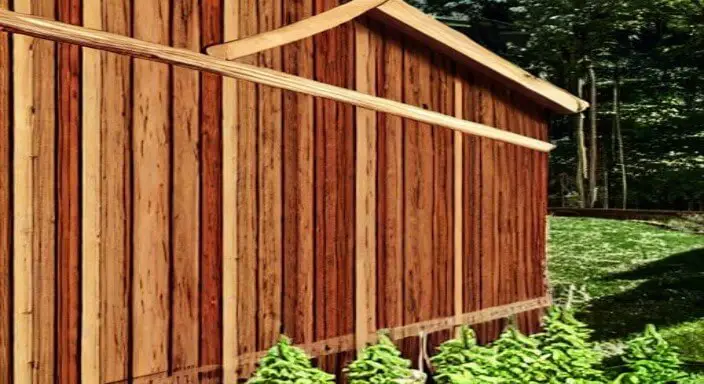As homeowners and outdoor enthusiasts, we all want our wooden structures, furniture, and decor to survive harsh weather elements and offer durability for years. Whether you are working on a new outdoor project or revitalizing an old, worn-out piece of wood, the importance of weatherproofing cannot be understated. Let’s see how to weatherproof wood for outdoors.
To protect your wooden structures, you must ensure they are built to withstand the extreme conditions they will inevitably face.
From rain to snow to harsh sunlight to moisture, a high-quality sealant will increase the longevity of your woodwork while maintaining its natural beauty.
However, choosing the right products and techniques for weatherproofing wood outdoors can be challenging.
This Home Affluence post will look at some of the best ways to seal and protect wooden surfaces by fortifying their strength and enhancing their aesthetic:
- Identify the Type of Wood
- Choose the Right Wood
- Clean the Wood
- Sand the Wood
- Apply Primer
- Apply Exterior Paint
- Apply Paint or Stain
- Seal the Wood
- Apply Varnish
- Seal the Wood
- Apply a Protective Coating
- Apply Polyurethane
- Apply a Varnish
- Maintain Weatherproofed Wood
We will discuss the different types of stains, sealants, and other materials used and highlight the pros and cons of each.
How To Weatherproof Wood For Outdoors
1. Identify the Type of Wood
If you want to protect your wooden outdoor furniture, deck, or fence from the elements, it’s essential first to identify the type of wood you’re working with.
Different types of wood have varying levels of natural resistance to water and decay, affecting your approach to weatherproofing it.

For example, cedar and redwood are naturally resistant to water and insects, while pine and spruce are more porous and prone to decay.
You can also use a moisture meter to determine the moisture content of the wood before applying any sealant or finish.
2. Choose the Right Wood
Choosing the right type of wood can make all the difference when weatherproofing wood outdoors.
Not all wood is created equal; some wood species are naturally more resistant to weathering than others.
For example, cedar and redwood contain natural oils that make them resistant to rot, decay, and insect damage. Teak wood is another excellent option due to its natural water-resistant properties.

On the other hand, some wood species are unsuitable for outdoor use and can deteriorate if exposed to moisture.
So, choosing a suitable wood species that can withstand the elements and resist water damage for an extended period is crucial.
Selecting the appropriate wood species will pay dividends in the long run, saving you time, effort, and money from prematurely fixing or replacing your outdoor wood structures.
3. Clean the Wood
Properly cleaning the surface is a crucial first step when weatherproofing wood for outdoor use.
The cleaning process involves removing all dirt, debris, and traces of previously applied finishes or coatings that may impact the new coating’s adhesion.
First, use a stiff-bristled brush or a power washer to remove all surface dirt and grime.
Once the surface is clean, sand the wood with medium-grit sandpaper to remove any remaining debris and slightly roughen the surface.

It is essential to wear protective equipment such as goggles and a mask while sanding to avoid inhaling dust particles.
After sanding, use a tack or damp cloth to wipe down the surface and remove any remaining dust.
Ensuring the surface is cleaned correctly will allow the weatherproofing materials to adhere appropriately, guaranteeing maximum protection for outdoor wood surfaces.
4. Sand the Wood
Weatherproofing wood for outdoor use is essential to ensure its longevity and protection from various weather elements.
One of the critical steps in this process is sanding the wood.
Sanding the surface of the wood can remove any rough spots, splinters, and imperfections that may capture moisture and promote rot.

It also smoothens the surface of the wood, making it more receptive to weatherproofing sealants.
Be sure to begin with, a coarse grit sandpaper and gradually move up to a finer grit to achieve the desired texture.
After sanding, use a clean cloth to wipe away any dust or debris and apply the weatherproofing solution to the wood’s surface.
Properly sanding the wood can ensure it’s adequately prepared to withstand harsh outdoor conditions and maintain its natural beauty for years.
5. Apply primer
One of the most critical steps in protecting outdoor wood is to apply a quality primer.
A good primer fills the wood’s pores, preventing water from penetrating and acting as an adhesive for the paint or stain.

Before starting:
- Check the weather forecast to ensure no rain or high humidity is forecasted for the next few days. It will ensure that the primer dries appropriately and adheres to the wood.
- Choose a primer designed for outdoor use and compatible with the paint or stain you plan to use.
- Follow the manufacturer’s instructions for mixing and applying the primer, using a high-quality brush or roller for an even coat.
- Allow the primer to dry completely before applying the next coat of paint.
With the proper preparation, a quality primer helps to protect your outdoor wood from the elements and extend its lifespan.
6. Apply Exterior Paint
If you’re looking to weatherproof wood outdoors, one crucial step is to apply exterior paint.
Not only will this enhance the aesthetic of your outdoor space, but it will also act as a protective barrier against the elements.
Before beginning, ensure that the surface to be painted is clean, dry, and free of any existing coatings. Next, select a high-quality exterior paint that is suitable for use on outdoor wood surfaces.

Choosing a paint designed to withstand moisture, UV rays, and other environmental factors are essential.
When applying the paint, use even strokes and thoroughly cover the entire surface.
It is recommended to apply two coats for maximum durability.
With proper application and maintenance, exterior paint can effectively weatherproof wood for outdoor use and extend its longevity.
7. Apply Paint or Stain
Applying paint or stain to wood is one of the most effective ways to weatherproof it outdoors.
Choosing the right paint or stain is essential as applying it correctly. Oil-based paints and stains are more durable and last longer than water-based ones.
However, water-based products are easier to clean up and have less of an odor. When applying the paint or stain, you can use a brush, roller, or sprayer to coat the wood evenly.

It’s also essential to allow sufficient drying time and to apply multiple coats if needed.
Follow label instructions closely; some products may require additional steps like sanding or priming before application.
8. Seal the Wood
If you’re looking for a way to weatherproof wood for use outdoors, one of the critical steps is to seal it properly. Sealing the wood can protect it against moisture, UV rays, and other environmental factors that can cause damage over time.
The good news is that this process doesn’t have to be complicated or complex, and you can do it yourself with just a few simple tools and materials.

With these tips and tricks, you can ensure that your outdoor wood projects look great for years.
9. Apply varnish
One effective way to protect your outdoor wooden structures from harsh weather conditions is by applying varnish.
Varnish is a protective layer to prevent rain, snow, and moisture from infiltrating the wood, causing rot or decay. The varnish enhances the aesthetics, giving the wood a glossy and polished finish.

Before applying varnish, ensure the wood is clean and free from dirt or debris.
Sand the surface evenly to create a smoother finish and ensure no roughness.
When applying the varnish, use a good quality paintbrush and work evenly and methodically.
After the first coat has dried, lightly sand the surface before wiping it clean and applying a second coat.
Allow the varnish to dry completely before exposing the wood to outdoor conditions.
With consistent care and maintenance, the varnish will keep the wood weatherproof for years.
10. Seal the Wood
Weatherproofing wooden outdoor furniture or structures like decks is essential to maintain the durability and prevent rot and decay.
One essential step in this process is to seal the wood. Sealing the wood with a protective coating helps keep moisture out and prevents the wood from weakening over time.
Several sealers are available in the market, from natural oils to acrylics, and each has advantages and disadvantages.

Choosing the suitable sealer is vital based on your specific needs, the type of wood used, and the environment it will be exposed to.
Proper sealer application is also crucial to ensure the wood is thoroughly coated and protected against the elements.
By sealing your outdoor wooden furniture or structures, you can significantly extend their lifespan and keep them looking and functioning great for many years.
11. Apply a Protective Coating
When it comes to outdoor wood structures and furniture, protecting them from the elements is crucial to ensure their longevity and aesthetic appeal.
A protective coating is an effective solution that provides a barrier against moisture, UV rays, and temperature fluctuations that can cause cracking, warping, and decay.
However, choosing the right type of coating and applying it is essential to achieve the desired results.

It’s essential to consider factors such as the type of wood, the exposure to sunlight and rain, and the desired finish.
A professional painter or contractor can provide expert advice and ensure the coating is applied evenly and thoroughly.
By taking the necessary steps to weatherproof your outdoor wood, you can enjoy your investment for years to come.
12. Apply polyurethane
Applying polyurethane is an intelligent move when protecting wood surfaces from outdoor elements.
This durable and weather-resistant coating works wonders on decks, furniture, and other wood structures exposed to rain, wind, and sunlight.

To apply polyurethane:
- Start by cleaning the wood surface thoroughly and allowing it to dry completely.
- Use a brush or roller to apply a thin, even coat of polyurethane, being careful not to create bubbles or streaks.
- Allow the first coat to dry before applying a second coat for added protection.
With proper application and maintenance, polyurethane can help extend the life of your outdoor wood structures and keep them looking great for years to come.
13. Apply a Varnish
Applying varnish to weatherproof wood for outdoor use is crucial in protecting the wood from weather elements such as rain, snow, and humidity.
The varnish acts as a protective layer by sealing the wood’s surface, preventing water from penetrating the wood and causing rot, mold, and decay.
It is essential to follow the manufacturer’s instructions carefully and choose the appropriate type of varnish for the treated wood.

It is also recommended to clean and prepare the wood properly before applying the varnish.
By taking the time to apply a varnish properly, the wood will be able to withstand years of exposure to the elements, ensuring that it remains strong and durable.
14. Maintain Weatherproofed Wood
Weatherproofing is essential for the longevity and durability of outdoor furniture and structures. Maintaining weatherproofed wood is crucial to ensuring your outdoor investments remain functional and visually appealing for many years.
It involves regular cleaning, sealing, and staining of the wood and addressing issues like cracks or rotting.

By taking the time to maintain weatherproofed wood, you can save yourself the hassle and expense of replacing or repairing outdoor furniture and structures that the elements have damaged.
Please pay attention to this important aspect of outdoor maintenance, as it can significantly extend the lifespan of your investments.
My Opinion
Weatherproofing wood for outdoor use is essential to ensure the longevity and safety of your wooden structures. Using the proper methods and materials can significantly extend the life of your outdoor wooden furniture, decks, and other structures.
From sealing to staining, many options are available to protect your wood from moisture, sunlight, and extreme temperatures.
Remember to choose the best weatherproofing techniques based on the specific conditions of your outdoor environment.




